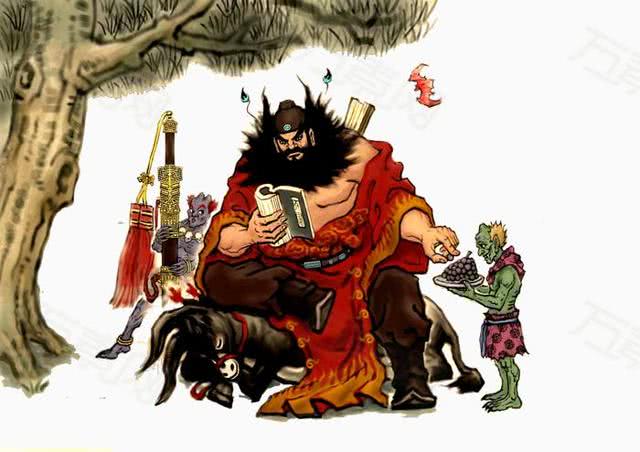
钟馗介绍 / Introduction to Zhong Kui
AdminYupShare
钟馗,是中国传统文化中一位家喻户晓的神祇和人物形象。他既是驱鬼辟邪的万应之神,又是刚正不阿的正义象征。其形象独特,故事传奇,融合了道教、民间信仰和民俗文化,在绘画、文学、戏剧等多个领域都有深远影响。
Zhong Kui is a household deity and figure in traditional Chinese culture. He is both the versatile god who exorcises ghosts and wards off evil, and a symbol of unwavering justice. With his unique image and legendary stories, he blends Daoist, folk beliefs, and cultural traditions, exerting a profound influence in various fields such as painting, literature, and drama.

#### 形象特征 / Iconography
- **面貌丑陋威严:** 最显著的特征是其豹头环眼、铁面虬髯的凶猛丑陋相貌。但这并非邪恶之相,而是充满正气,令鬼怪望而生畏的威严之容。
* **Fierce and Majestic Visage:** His most prominent feature is his fierce and ugly appearance: a leopard-like head with round, bulging eyes, an iron-faced countenance, and coiling beard. This is not an image of evil but one filled with righteous energy, a majestic look that makes evil spirits tremble with fear.
* **身着官袍:** 通常身穿唐代官员的红色袍服,头戴乌纱帽,表明他虽未能成为状元,但已被皇帝敕封为“驱魔大神”。
* **Official's Robes:** He is usually depicted wearing the red robes of a Tang Dynasty official and a black gauze cap, indicating that although he failed to become the top scholar in the exams, he was posthumously appointed by the emperor as the "Great God of Exorcism."
* **手持法器:** 常见的形象是手持宝剑(斩妖剑),脚下踩着小鬼。有时也配以蝙蝠(“蝠”与“福”同音,象征引福归堂)、蒲扇、纸伞等物品。
* **Holding Ritual Implements:** He is commonly shown holding a sword (a demon-slaying sword) and trampling a small demon underfoot. He is sometimes accompanied by a bat (the Chinese word for bat, "fu," sounds like the word for good fortune, symbolizing the ushering in of blessings), a palm-leaf fan, or a paper umbrella.

#### 核心故事与起源 / Core Story and Origin
钟馗最为人熟知的故事源于北宋沈括的《梦溪笔谈》,其起源可追溯至唐代。
The most famous story of Zhong Kui originates from Shen Kuo's "Dream Pool Essays" from the Northern Song Dynasty, though its roots can be traced back to the Tang Dynasty.
- **才华横溢的举子:** 钟馗本是终南山下一名才华横溢、学富五车的书生。
2. **A Talented Scholar:** Zhong Kui was originally a brilliant and immensely learned scholar from the foot of Zhongnan Mountain.
3. **殿试受挫:** 他赴京城参加殿试,因其出色的文章和英武的气概被主考官推荐为状元。然而,当皇帝面试时,却因他相貌极其丑陋而取消了他的状元资格。
4. **Setback at the Palace Examination:** He traveled to the capital to take the palace examination. His excellent essay and imposing demeanor led the chief examiner to recommend him as the top scholar (Zhuangyuan). However, during the emperor's interview, his title was revoked solely because of his extremely ugly appearance.
5. **刚烈自尽:** 钟馗生性刚烈,不堪受此大辱,愤而撞殿阶自杀而亡。
6. **Righteous Suicide:** Zhong Kui, being a man of unyielding integrity, could not bear this great humiliation. In anger and despair, he killed himself by smashing his head against the palace steps.
7. **皇帝敕封:** 后来,唐玄宗李隆基在病中梦见一个小鬼偷窃宝物、戏弄贵妃。正在此时,一个穿着蓝袍、面貌丑陋的大鬼出现,捉住小鬼并将其挖眼吞食。大鬼自称是当年冤死的钟馗,发誓要为陛下扫清天下妖邪。玄宗梦醒后,病体痊愈。感念其忠烈,他下旨请画家吴道子绘制了钟馗像,并敕封钟馗为“驱魔大神”,遍行天下以斩妖邪。
8. **Imperial Decree and Enfeoffment:** Later, Emperor Tang Xuanzong (Li Longji), while ill, dreamed of a small demon stealing his treasures and harassing his concubine, Yang Guifei. Suddenly, a large, fearsome ghost in blue robes appeared, captured the small demon, gouged out its eyes, and devoured it. The large ghost introduced himself as Zhong Kui, who had been wrongfully killed, and swore to eradicate all evil spirits for the Emperor. Upon waking, Xuanzong recovered from his illness. Grateful for Zhong Kui's loyalty and fervor, he ordered the painter Wu Daozi to create a portrait of Zhong Kui and posthumously bestowed upon him the title "Great God of Exorcism," commanding him to travel the world and vanquish all evil.

#### 职能与象征意义 / Functions and Symbolism
- **驱鬼辟邪:** 这是钟馗最核心的职能。人们将他的画像(尤其是春节期间)贴于家门、墙壁上,用以震慑和驱逐妖魔鬼怪,保佑家宅平安。
* **Exorcising Ghosts and Warding Off Evil:** This is Zhong Kui's core function. People post his image (especially during the Chinese New Year) on doors and walls to intimidate and drive away evil spirits and demons, ensuring the safety and peace of the household.
* **伸张正义:** 钟馗代表了对不公和冤屈的平反。他因自身冤死而特别同情弱者,成为追求公平正义的化身。
* **Upholding Justice:** Zhong Kui represents the redress of injustice and wrongful grievances. Having been wronged himself, he is particularly sympathetic to the weak and has become an embodiment of the pursuit of fairness and justice.
* **赐福镇宅:** 因“钟馗捉鬼”的故事,他又衍生出“捉鬼送福”的含义。常见的“钟馗引福”图,描绘他指引蝙蝠(福)飞来,寓意将福气引入家中。
* **Bestowing Blessings and Protecting the Home:** From the story of "Zhong Kui catching ghosts," he also derived the meaning of "catching ghosts and delivering blessings." A common motif is "Zhong Kui Ushering in Blessings," which depicts him guiding a bat (a homophone for "blessing" in Chinese) to fly in, symbolizing bringing good fortune into the home.
* **考试之神:** 因其书生出身和才学,他也被部分读书人视为守护神,祈求在科举(及现代考试)中取得好成绩,避免遭遇不公。
* **God of Examinations:** Due to his background as a scholar and his great learning, he is also regarded by some students as a patron deity, prayed to for success in imperial examinations (and modern exams) and to avoid unfair treatment.

#### 文化影响 / Cultural Influence
- **绘画艺术:** 钟馗是传统人物画的重要题材。从吴道子开始,历代名家如黄荃、龚开、任伯年等都创作过经典的钟馗画作。
* **Painting Art:** Zhong Kui is an important subject in traditional figure painting. Starting with Wu Daozi, renowned artists throughout history such as Huang Quan, Gong Kai, and Ren Bonian have all created classic paintings of him.
* **戏曲戏剧:** 京剧和各种地方戏中都有《钟馗嫁妹》等经典剧目,讲述他成为鬼神后,仍不忘人间情谊,带领鬼卒将妹妹风风光光嫁予恩人的故事,展现了其铁汉柔情的一面。
* **Opera and Theater:** Traditional Chinese operas, including Peking opera and various regional forms, feature classic plays like "Zhong Kui Marries Off His Sister." This story tells how, after becoming a spirit, he still remembered his human bonds and led his demon subordinates to grandly marry his sister to his benefactor, showing his tender side beneath the fierce exterior.
* **节日习俗:** 主要与春节和端午节相关。春节贴钟馗像辟邪,一些地方在端午节也有悬挂钟馗像以“驱五毒”的习俗。
* **Festival Customs:** He is primarily associated with the Chinese New Year and the Dragon Boat Festival. His image is posted during New Year for protection, and some regions also hang his portrait during the Dragon Boat Festival to "ward off the five poisonous creatures" (centipedes, venomous snakes, scorpions, lizards, and toads).

总而言之,钟馗是一个复杂而深入人心的文化符号,他从一个悲剧性的文人,转变为一位强大的守护神, embodying the spirit of justice, protection, and the triumph of righteousness over evil.
In summary, Zhong Kui is a complex and deeply ingrained cultural symbol. He transformed from a tragic scholar into a powerful guardian deity, embodying the spirit of justice, protection, and the triumph of righteousness over evil.
